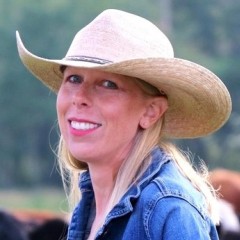Have you ever acted on the recommendations of experts?
Many will agree expert advice is great — however, to follow through with it often costs money and time. But Charlie Christie and Terri Mappin are two producers who listened, decided to give it a go and are glad they did.
At wit’s end
A very bad outbreak of coccidiosis stands out for Christie.
“One year we lost 12 calves in a week, and I was just sick,” said the Trochu-area mixed farmer.
“We were treating water; we were treating calf feed; trying to get whatever we could orally into the calves.”

A nutritionist suggested he try feeding his cows Rumensin (a feed additive that kills the parasites that cause coccidiosis) via mineral about three to four months before calving. Since Christie was already feeding his cows with a TMR mixer, adding Rumensin was easy.
“We feed every day, and I like to know exactly what the cows are getting every day. I like to make sure they are getting their mineral every day.”
It added to his feed costs, although it doesn’t get rid of coccidiosis, “it really cuts it back.”
“It doesn’t take much to pay for it,” he said.
Grain to grass
Mappin also had a big problem that arrived suddenly — but in this case, the change it sparked was much more extensive.
She and her husband run a mixed farm with a cow-calf operation near Byemoor and she had grown curious about extended grazing as she had seen a lot of folks on social media talking about how successful it had been for them. However, they had traditionally sold their yearling calves in the spring for the grass market.
But when the pandemic hit two years ago, she found that market had disappeared for the time being.

“We had been to a field day with Graeme Finn and Union Forage,” said Mappin. “So we called Graeme up and said, ‘We’ve got all our calves still. What are we going to do?’”
The call resulted in the purchase of a blend designed to be grazed twice in a year, which was seeded to 185 acres of grain land. (As well, some former grain land was seeded for swath grazing.)
After the yearlings were turned into the mix at the end of June, it was also rotationally grazed with the cow-calf pairs until the end of August. Some well-timed rains also allowed her to cut and bale 100 acres for greenfeed. The next spring, the area was used for calving in May and June and afterwards a group of cull cows and calves were brought in to graze. And despite the hot, dry summer, there was enough regrowth that she was able to silage it.
Read Also

Grazing ‘sweet spot’ boosts pasture performance
Timing-focused approach to pasture management touted to boost forage growth, livestock gains while also cutting farmer labour and inputs
Those results have Mappin continuing down this new road.
“By the fall of 2021, we went back into the Double Down blend and direct seeded a blend of fall triticale and sweet clover,” she said. “We’re hoping the stars will align, the moisture will return, and the same 185 acres will be as productive in 2022.”
It was so successful, Mappin is now taking more grain land out of production and using grazing in their crop rotation.
“Although we took 185 acres of cropland out of our grain acres, we essentially gained two years of production (through grazing, making greenfeed, and silage) off of the same 185 acres for a minimal cost,” she said. “That only added value to our operation and we will continue to incorporate more grazing blends into our grain acres as part of our rotation.”
In fact, Mappin is now looking at cropland with a different eye. The rising costs of inputs have made her wonder if it is worth cropping marginal land.
“Do you break more land (for crop) or do you maximize what you have with the tools in your chest?”
Glad he convinced Dad
Christie has also stepped back, done a major rethink and made his operation more profitable.
He still remembers an evening about 30 years ago, when he went to an information night put on by his local vet and he learned about using a live BVD vaccine.
At the time, the operation only vaccinated calves, and cows only received pour-on and 8-way. While Christie was impressed by what he heard, he had to do some convincing of his own when he got back to the farm.
“It was a little tricky to talk my dad into doing the pre-breeding vaccines,” he said.
But he was successful and they started using the live BVD vaccines.
“It took a little bit to implement, (at the time) we didn’t take the time to run through cows (to vaccinate).”
Bovine viral diarrhea can be the start for a lot of problems, and Christie said once they started vaccinating it really helped mitigate death losses at calving and throughout the year.
“Now what we do, once they (heifers) have been given their shots in the spring pre-breeding as heifers, we will use that live vaccine on a pregnant cow now. It’s quite easy, they get vaccinated once a year.”
In the past it has been argued that live vaccines in pregnant cows can cause them to abort. However, labels advise if the live vaccine is going to be administered to pregnant cows, the cow needs to be vaccinated with the same live vaccine either as a heifer pre-breeding or within 12 months (depending on the vaccine).
It’s an issue Christie has watched closely.
“Every time you run cows through the chute you stand to lose a calf or two depending on the numbers you run,” he noted. “We have seen this happen. Was it due to the live BVD vaccine? I really don’t think so and we’ve never seen a measurable increase since we started doing the BVD vaccines (on pregnant cows). We do insist on vaccinating the open heifers pre-breeding for this very reason.”
As with the coccidiosis treatment or Mappin’s move to extended grazing, the ultimate test for trying something new is the bottom line.
And Christie doesn’t mince words on the decision he made three decades ago to try something very different.
“It definitely paid,” he said.
















